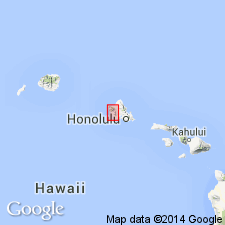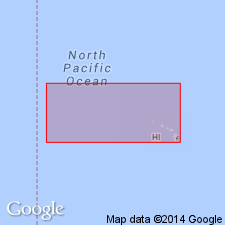
- Usage in publication:
-
- Black Point limestone
- Modifications:
-
- Original reference
- Dominant lithology:
-
- Limestone
- AAPG geologic province:
-
- Oahu
Summary:
Black Point limestone. Is highest marine limestone known on leeward side of Koolau Range. Occurs 48.2 feet above sea level where it underlies Diamond Head tuff. Contains OSTREA KAMEHAMEHA Pilsbury (identified by J.M. Ostergaard). [Age not stated.]
[Named from Black Point (Kupikipikio Point), Island of Oahu, HI.]
Source: Modified from GNU records (USGS DDS-6; Menlo GNULEX).

- Usage in publication:
-
- Black Point limestone
- Modifications:
-
- [Principal reference]
- Age modified
- AAPG geologic province:
-
- Oahu
Summary:
Black Point limestone. Very limited exposures. Underlies Diamond Head tuff and Black Point basalt. Age is considered Pleistocene (Kaena or Laie stands of sea).
[Principal reference]: east shore of Black Point [Kupikipikio Point, Lat. 21 deg. 15 min. 30 sec. N., Long. 157 deg. 47 min. 40 sec. W., Honolulu 7.5-min quadrangle, Honolulu Co.], Island of Oahu, HI.
[Lat./Long. coords. from GNU records (USGS DDS-6; Menlo GNULEX, compiled September, 1988).]
Source: Modified from GNU records (USGS DDS-6; Menlo GNULEX).
For more information, please contact Nancy Stamm, Geologic Names Committee Secretary.
Asterisk (*) indicates published by U.S. Geological Survey authors.
"No current usage" (†) implies that a name has been abandoned or has fallen into disuse. Former usage and, if known, replacement name given in parentheses ( ).
Slash (/) indicates name conflicts with nomenclatural guidelines (CSN, 1933; ACSN, 1961, 1970; NACSN, 1983, 2005, 2021). May be explained within brackets ([ ]).

